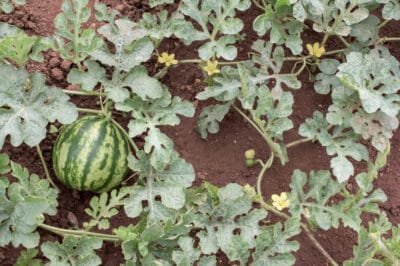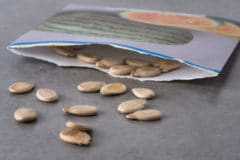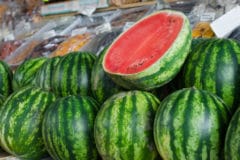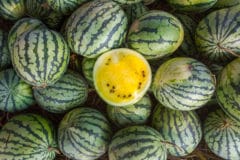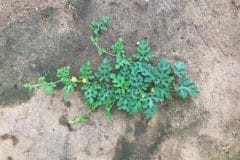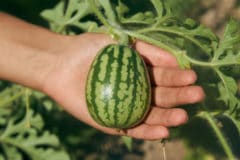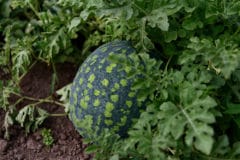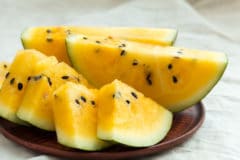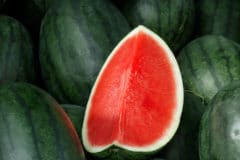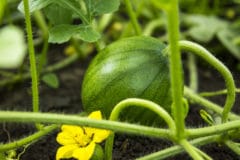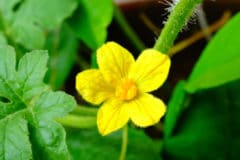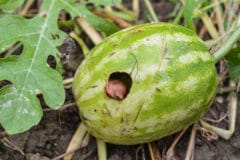What time of year can I grow watermelon plants?
Watermelons are warm-season annuals and are sensitive to frost. These heat-lovers thrive when temperatures range between 70°F and 85°F (21.1°C and 29.4°C), but still handle temperatures of 90°F (32.2°C). Once temperatures warm in spring and there’s no threat of frosts, you can grow watermelons.
What varieties for those with a short season?
Unless you live in Florida, where watermelons are produced year-round, you’ll want to grow a variety that ripens before your season turns cold. Regardless of where you live, there’s a watermelon variety suitable for your climate.
- ‘Blacktail Mountain’ produces 6- to 12-pound, red-flesh fruit with dark green skin. More tolerant to cold and matures in around 70 days.
- ‘Snack Pack’ produces 3- to 4-pound fruits, with dark green skin and red flesh. Matures in around 75 days.
- ‘Sweet Dakota Rose’ is an heirloom producing 10- to 20-pound, bright red-fleshed fruits. Good for shorter seasons as it matures in around 60 days.
How much space do I need?
The seed packet usually states how big the particular watermelon variety grows, as well as the required spacing between multiple plants. However, if you aren’t sure, a standard rule is to plant multiple plants/hills 3 feet apart and multiple rows about 8 feet apart.
Although all varieties of watermelons produce vines, some types, especially dwarf varieties, produce shorter vines and are suitable for growing in large containers.
How much light do watermelons require?
For the best growth, production of blossoms and fruit, grow watermelon plants in a site that receives full sun for the majority of the day.
What type of soil produces the best growth?
Watermelons perform best in well-drained, rich, sandy loam soil. If your soil is extremely poor, you can amend with several inches of well-rotted manure or compost, working it into the native soil about 6 inches.
What size container should I use?
If you don’t have garden space, you can grow watermelons in a large, 5-gallon (18.9-liter) container that has bottom drainage. Any type of material works well, but remember that clay pots dry out quicker than pots made of plastic, so require more frequent watering.
Dwarf cultivars produce shorter vines and smaller fruits, making them a good choice for potted culture and growing up a trellis.
What watermelon varieties are good choices for growing in containers?
Although you can grow any variety of watermelons in a container, dwarf types have manageable, shorter vines and produce smaller and lighter fruit. Vines and fruit are easily supported on a trellis without it toppling over. Some good varieties include:
- ‘Golden Midget’ produces 3-pound fruits, with golden yellow skin and pink inner flesh. Matures in around 70 days.
- ‘Sugar Baby’ produces 9-pound fruits, with green skin and red flesh. Matures in about 75 days.
- ‘Snack Pack’ produces 3- to 4-pound fruits, with dark green skin and red flesh. Matures in around 75 days.
How to plant seeds and transplants?
If you want to get a head start of your watermelon plants, you can plant the seeds in peat pots and then transplant in the garden several weeks later. Watermelons, like all members of the Cucurbitaceae family, have sensitive roots and don’t take to transplanting well. Therefore, it’s important to start the seeds in peat pots where the entire pot is planted in the garden.
Plant watermelon seeds 1/2 inch deep, cover with soil and water. If direct sowing seeds in a container, plant three seeds and then thin to the strongest seedling. If planting in hills, plant four to six seeds per hill, and then thin to the strongest two to three seedlings.
How long does it take for seeds to germinate?
Germination time depends on the temperature. When soil temperatures range around 95°F (35°C), watermelon seeds emerge in around three to five days. In cooler temperatures around 70°F (21.1°C), it can take a week for the seeds to germinate.
Can I grow watermelons vertically?
Watermelon cultivars producing smaller fruits work well growing vertically on a structure like a trellis. Make sure the structure is strong, stable and won’t fall over as the melons develop some weight. Watermelons aren’t natural climbers, so you’ll have to gently coax the vines up the structure.
Once the fruit develops in size of a golf ball or tennis ball, create slings out of pantyhose to hold them and tie the ends to the vertical structure. You can also use mesh bags like onion bags.
How much water do watermelon plants require?
Watermelon plants are deep-rooted, growing about a foot into the soil, and require consistent moisture, especially during their early stage through the first development of fruits. After the fruits are developing, you can cut back watering to about half. Too much water, especially several weeks before harvesting, can negatively affect the fruit’s sweetness. Applying a layer of mulch around plants helps conserve moisture and cuts down on weed growth.
Drip irrigation works best as it doesn’t get water on the plant’s foliage which can cause issues with disease. However, if you have to water from overhead, do so in the morning so the foliage has time to dry.
What about fertilizing watermelon plants?
Once the watermelon plants start vining, creeping along the ground, side dress by spreading compost or well-rotted manure next to the plants and watering in well. You can also use an organic blend of a 33-0-0, following label directions on amounts and watering in well after applying. Don’t overfertilize with too much nitrogen because you’ll get lush vines at the expense of flowers and fruits.
What are some common watermelon pests?
Most of the pests affecting watermelon plants cause problems during the early stages of plant development. The best course of action is paying attention to the plants and dealing with the problem as soon as you notice the pests and before they’ve multiplied into a large infestation.
Some of the common watermelon pests include:
- Melon Aphids (Aphis gossyppi): Melon aphids are sap-suckers mainly found on the underside of leaves. The aphids can be winged or wingless, and range in colors of black, green or yellow. Watermelon plants in the runner stage are most susceptible. Problems include leaf curl, browning and leaf death, as well as a reduction in fruit and fruit quality.
- Spider Mites (Tetranynchus urticae): Spider mites are sap-sucking insects that are yellowish to greenish. The insects spin protective webs over plants, making an infestation easy to identify. Damage includes yellow and bronze leaves, which if left untreated, causes leaf drop and eventual plant death.
- Thrips: Thrips are small sap-sucking insects that are yellow with hairy wings held over the insect’s back. The adult lays eggs inside the plant tissue of the watermelon, which damages mature and developing plants, blossoms and fruit.
What are some eco-friendly pest-control products?
To protect beneficial pollinators and predatory insects that attack unwanted pests, use eco-friendly products such as insecticidal soap, neem oil and pyrethrin. So you don’t damage the watermelon plant, test the product on a small section of foliage before spraying the entire plant. It’s best to treat when conditions aren’t sunny or hot.
Always follow label directions on mixing and amounts. Thoroughly spray all parts of the watermelon plant and treat again in a week.
What are some common watermelon diseases?
Depending on environmental conditions, disease problems can change from year to year, but are most prevalent when conditions are wet and humid. Some common problems include:
- Powdery Mildew: Shows up as a white powdery substance on foliage. Reduce the problem by not watering plants overhead and getting the foliage wet. If you don’t have drip irrigation, water early in the day so the leaves have a chance to dry. Space plants appropriately so there’s proper circulation of air between multiple plantings.
- Cucumber Mosaic Virus: Caused by aphids. The virus causes mottling and distortion of foliage and fruit, leaf cupping and a general decline in vines. Treat aphids with an insecticidal soap. Remove and destroy infected plants.
- Blossom End Rot: Caused by too much nitrogen fertilizer, calcium deficiency and stress caused by drought. Fertilize properly and keep developing plants properly watered.
How to tell if a watermelon is ready for harvesting?
The seed packet of your particular watermelon variety will tell you approximately how many days it takes before you can expect to harvest. Depending on the cultivar, watermelons can take anywhere from 70 to over 100 days before they are ripe and ready for picking.
One sign of ripeness is the tendril attached to the fruit turns brown and dries out. Other signs of ripeness are the belly or side of the melon laying on the ground turns yellowish, and some people judge ripeness by thumping the watermelon and listening for a dull, hollow sound.
How long can you store a watermelon?
A whole watermelon stored at room temperature generally stays fresh from a week to two weeks. For the best taste, cool the melon in the refrigerator before eating or using. Watermelon is a great-tasting, low-calorie food that holds a lot of nutritional value. Eat them fresh, use in salads or beverages.
